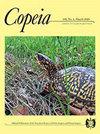Sexually Dimorphic Heads of Eurycea bislineata
IF 2.6
Q2 Agricultural and Biological Sciences
引用次数: 6
Abstract
Gladwyn Kingsley Noble was the first investigator to collectively examine courtship glands and correlate their function to the tail-straddling walk in plethodontid salamanders. While mental glands and caudal courtship glands have received the majority of attention since Noble's seminal work, Noble described other glands from Eurycea bislineata that were putatively involved in courtship that have received little or no attention (e.g., glands at the temporal regions of the heads of males). Previous studies demonstrated that heads of males enlarge during the mating season and some studies indicated that the enlargement was because of Noble's previously described temporal glands; however, current consensus of male head enlargement is that skeletal muscle hypertrophy is the cause of the head growth. In this study, we examined male and female E. bislineata throughout the year to test Noble's hypothesis that males possess courtship glands in the integument of the temporal regions of their heads and to assess what underlying tissues are involved with male head enlargement during mating. We found that the temporal regions of male heads change dramatically from non-mating to mating months, exemplified by two-dimensional geometric morphometrics. This variation is a result of M. levator mandibulae externus hypertrophy rather than glandular activity underlying the integument. Although no glandular masses isolated at the temporal regions of the heads result in this dynamic shape change, simple alveolar glands that resemble stereotypical courtship glands are found in the integument of only males from the mating season. These putative courtship glands are scattered amongst mucous and serous glands within the integument around the eyelids to at least the posterior termination of the cranium. The function of these glands is unknown but is probably involved with pheromone production, similar to more thoroughly examined courtship glands.双叶芡实两性二形的头状花序
格拉德温·金斯利·诺布尔(Gladwyn Kingsley Noble)是第一个集体研究求爱腺并将其功能与多齿蝾螈跨尾行走联系起来的研究者。自从Noble的开创性工作以来,心理腺和尾侧求偶腺受到了大部分的关注,Noble描述了来自Eurycea bislineata的其他腺体,这些腺体被认为与求偶有关,但很少或根本没有受到关注(例如,雄性头部颞区的腺体)。先前的研究表明,雄性的头部在交配季节会变大,一些研究表明,这种变大是因为Noble先前描述的颞腺;然而,目前男性头部增大的共识是骨骼肌肥大是头部增长的原因。在这项研究中,我们全年检查了雄性和雌性的双线蛱蝶,以验证Noble的假设,即雄性在其头部颞区的外皮上拥有求偶腺,并评估在交配过程中,哪些潜在组织与雄性头部增大有关。我们发现,从非交配月份到交配月份,男性头部的颞区发生了巨大的变化,这是二维几何形态计量学的例证。这种变异是提上下颌分枝杆菌外肌肥大的结果,而不是被膜下腺体活动的结果。虽然在头部的颞区没有分离的腺体肿块导致这种动态的形状变化,但在交配季节,只有雄性的被皮上发现了类似于典型求爱腺的简单的肺泡腺。这些假定的求偶腺散布在眼睑周围被套内的粘液和浆液腺中,至少延伸到头盖骨的后端。这些腺体的功能尚不清楚,但可能与信息素的产生有关,类似于更深入研究的求偶腺体。
本文章由计算机程序翻译,如有差异,请以英文原文为准。
求助全文
约1分钟内获得全文
求助全文
来源期刊

Copeia
生物-动物学
CiteScore
2.10
自引率
0.00%
发文量
0
审稿时长
6-12 weeks
期刊介绍:
Founded in 1913, Copeia is a highly respected international journal dedicated to the publication of high quality, original research papers on the behavior, conservation, ecology, genetics, morphology, evolution, physiology, systematics and taxonomy of extant and extinct fishes, amphibians, and reptiles. Copeia is published electronically and is available through BioOne. Articles are published online first, and print issues appear four times per year. In addition to research articles, Copeia publishes invited review papers, book reviews, and compiles virtual issues on topics of interest drawn from papers previously published in the journal.
 求助内容:
求助内容: 应助结果提醒方式:
应助结果提醒方式:


